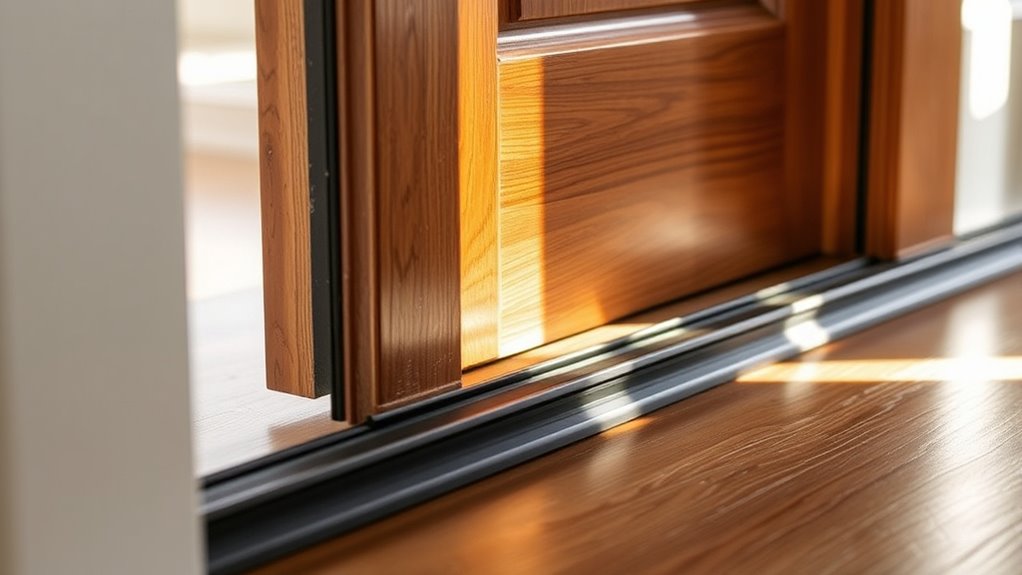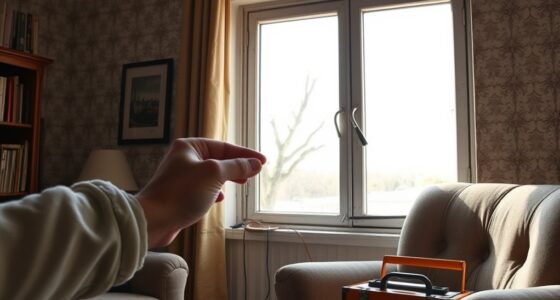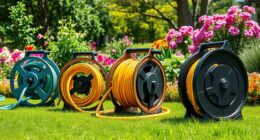Sealing drafts with door sweeps and weatherstripping is a quick and easy way to boost your home’s comfort and save energy. Start by inspecting your door and identifying gaps around the frame and bottom. Apply weatherstripping along the edges and install a door sweep at the bottom to block drafts, dust, and pests. Properly aligned seals will work best, and once installed, you’ll notice an immediate difference. Keep exploring to learn more tips for a perfectly sealed home.
Key Takeaways
- Inspect doors for gaps and cracks to identify draft points before installing weatherstripping or door sweeps.
- Choose suitable weatherstripping materials like foam tape or V-strip, and clean surfaces for proper adhesion.
- Apply weatherstripping along door frames, ensuring it sits flush for maximum sealing effectiveness.
- Measure and cut door sweeps to fit, then securely attach them to create a tight seal at the bottom of the door.
- Test the seal by feeling for drafts or using a tissue to ensure drafts are blocked, adjusting as needed.

If you want to keep drafts, cold air, and insects out of your home, door sweeps and weatherstripping are essential tools. These simple additions can make a significant difference in comfort and energy efficiency, especially when installed properly. The good news is that both DIY installation is straightforward, allowing you to save money while improving your home’s insulation. Taking a few minutes to seal gaps around your doors can transform your living space, making it warmer in winter and cooler in summer.
Start by inspecting your doors and the surrounding frames. Look for gaps or cracks where air might escape. Once you identify these trouble spots, choose the right weatherstripping material—foam tape, V-strip, or rubber gaskets work well for most doors. Applying weatherstripping is usually a matter of cleaning the surface, then sticking or pressing the material into place along the edges of the door frame. It’s a simple task that requires no special tools or experience, making it perfect for a DIY project. Properly installed weatherstripping not only helps seal out drafts but also boosts energy efficiency, reducing your heating and cooling bills over time.
Inspect doors and frames for gaps, then apply weatherstripping to improve insulation and energy efficiency.
Door sweeps are equally important. They are attached to the bottom of your door to block drafts, dust, and pests from entering underneath. To install a door sweep, measure the width of your door, then cut the sweep to size if needed. Attach it securely with screws or adhesive, depending on the type you choose. When installed correctly, a door sweep creates a tight seal that prevents cold air from sneaking in during winter and hot air from entering during summer. It also keeps insects and debris out of your home, making your space more comfortable and hygienic.
The key to a successful DIY installation is patience and attention to detail. Take your time aligning the weatherstripping and door sweep properly so they sit flush against the door and frame. This ensures maximum sealing and energy efficiency. Remember, the goal is to eliminate any gaps that could compromise insulation. Once installed, test your door by feeling around the edges for drafts or using a lit candle or tissue to see if the air moves around the seal. If you notice leaks, adjust or add more weatherstripping.
Additionally, understanding home insulation can help you identify other areas where sealing gaps can improve overall comfort and efficiency.
Frequently Asked Questions
Can Door Sweeps Be Installed on Sliding Glass Doors?
Yes, you can install door sweeps on sliding glass doors. Use sliding door seals designed for this purpose, which help block drafts effectively. You’ll need to check the track maintenance first to verify smooth operation and proper fit. Measure carefully and choose a sweep that fits your door’s bottom. Proper installation will improve energy efficiency and keep out drafts, making your space more comfortable in just an hour.
Are Weatherstripping Materials Suitable for Outdoor Use?
Absolutely, weatherstripping materials are built for outdoor battles! Their durability and outdoor resistance make them perfect to withstand rain, wind, and sun without losing their seal. You can confidently use these materials outside because they’re designed to handle the elements, keeping drafts at bay and your home cozy. Don’t worry about weather wear—these strips are tough enough to last through every storm and sunny day.
How Often Should I Replace Door Weatherstripping?
You should replace your door weatherstripping when you notice signs of wear, such as cracking, gaps, or difficulty sealing. Follow a regular maintenance schedule, checking it at least once a year, especially before winter. If it’s damaged or no longer effective at sealing drafts, replace it promptly to maintain energy efficiency. Keeping an eye on these signs helps ensure your home stays warm and your utility bills stay low.
What’s the Best Type of Weatherstripping for Uneven Door Gaps?
Think of it as a tailor fitting a suit—you need the right material for uneven door gaps. For this, flexible weatherstripping materials like foam tape or vinyl are your best options. They conform to irregularities during a door gap assessment, sealing gaps effectively. This ensures you get a snug fit, preventing drafts and energy loss. Choose these materials for a quick, efficient fix that adapts to your door’s unique shape.
Do Door Sweeps Affect Door Clearance and Operation?
Door sweeps can affect door clearance and operation if installed improperly or if they’re too thick. They might make it harder to open or close the door smoothly, especially if they rub against the threshold or floor. To avoid issues, choose a door sweep that fits your door’s gap and verify it’s installed correctly. Regularly check for any obstructions to maintain ideal door operation and clearance.
Conclusion
Now that you’ve sealed those drafts, imagine the comfort and savings waiting just around the corner. But don’t stop here—there’s more to improve your home’s energy efficiency and comfort. What unexpected cold spots or drafts might still be lurking? Keep exploring, stay curious, and you’ll uncover even more ways to make your home cozy and budget-friendly. The secret to a perfectly sealed home is just a few more steps away—are you ready to discover them?









